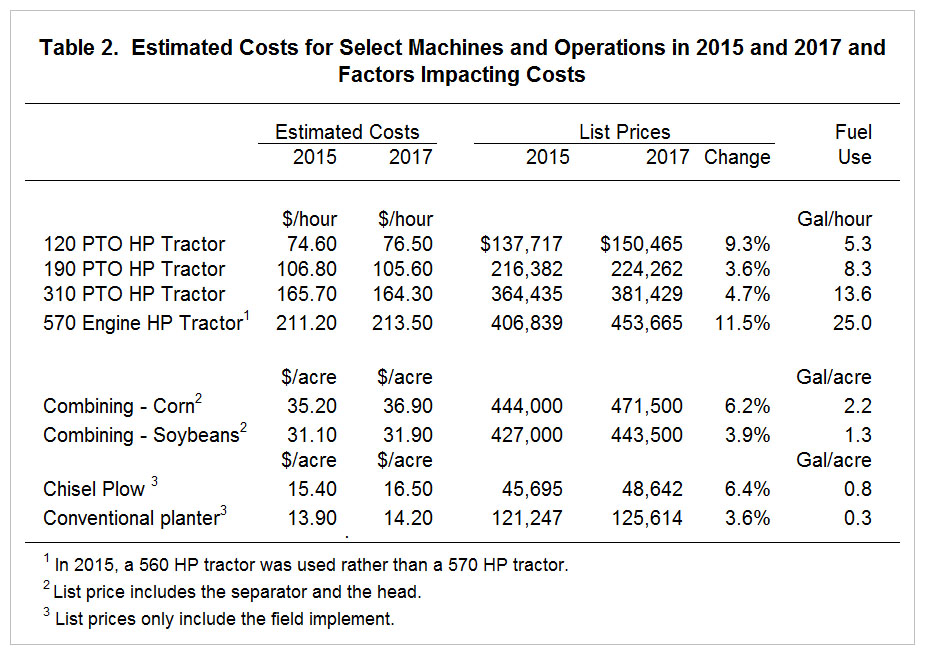Machinery Cost Estimates for 2017
Machinery cost estimates for various field operations and machines have been updated for 2017. The last time machinery costs were released on farmdoc was in 2015. Between 2015 and 2017, most per acre costs increased; however, some machinery costs decreased due to a lower diesel fuel price in 2017.
Machinery Cost Estimates for 2017
Estimated Machinery costs often are used to set custom rates when one individual performs a field operation for another individual. Only costs are included in estimates. An additional amount should be added for profit. Machinery costs estimates are available in the management section of farmdoc in five publications:
- Machinery Cost Estimates: Field Operations – Shows per acre costs of performing field operations such as chisel plowing, field cultivating, planting, and spraying.
- Machinery Cost Estimates: Tractors – Shows per hour costs of operating various horsepower tractors.
- Machinery Cost Estimates: Harvesting – Shows per acre costs of harvesting corn and soybeans, as well as use of grain cart.
- Machinery Cost Estimates: Forage Field Operations – Shows per acre costs of performing forage operations.
- Machinery Cost Estimates: Summary – Contains summary tables from the above operations.
Factors Impacting Estimated Machinery Costs
Costs are estimated in both 2015 and 2017 using an estimation approach that relies on formulas developed by the American Society of Agricultural Engineers (ASAE). From 2015 to 2017, most of the estimated machinery costs went up. However, some costs decreased.
Factors impacting costs will be illustrated for a 310 PTO horsepower tractor with front wheel assist. These costs are shown in the Machinery Costs Estimates: Tractors publication. Total costs were estimated at $165.70 per hour in 2015. Per hour decreased by $1.40 per hour to $164.30 per hour in 2017 (see Table 1).

Per hour costs are divided into overhead, fuel, and labor categories. Overhead includes depreciation, interest, insurance and housing, and repairs. Formulas are used to estimate each cost, and the purchase price enters into those formulas. The purchase price is assumed to equal 85% of the list price of the tractor. List prices were $364,435 in 2015 and $381,429 in 2017. Between 2015 and 2017, the list price increased. As a result, overhead costs increased from $105.90 in 2015 to $110.90 in 2017 (see Table 1), roughly the same percentage increase as the increase in list prices. More detail on the approaches used to estimate overhead costs are given in the Machinery Cost Estimates: Tractors publication.
Fuel use on a 310 horsepower tractor is estimated at 13.6 gallons per hour. The diesel fuel price was lowered from $2.50 per gallon in 2015 to $2.25 per gallon in 2017. Due to the fuel price decline, fuel costs for the 310 horsepower tractor decreased from $41.10 per hour in 2015 to $33.60 per hour in 2017 (see Table 1).
Labor costs per hour were increased from $18.70 per hour in 2015 to $19.80 per hour in 2017 (see Table 1). A $17 per hour rate was used in 2015 compared to an $18 per hour rate in 2017. Labor time is assumed to be 1.1 times the tractor hour resulting in a 10% higher cost per tractor hour.
For the 310 horsepower tractor, total costs decreased because the fuel cost decrease was larger than the overhead and labor cost increase. These same factors impacted all operations. The magnitude of an operation’s cost change depended on the size of overhead and labor cost increases relative to fuel cost decrease. Those machines having higher list price increases tended to have higher cost increases. Those operations that were more fuel intense had lower cost increases or cost decreases. Table 2 shows changes in a select number of machines and operations that illustrate magnitudes of changes from 2015 to 2017.

Factors Impacting Per Hour and Per Acre Costs
Per acre cost estimates are made based on assumptions concerning prices, interest rates, and use. In calculating costs, for example, 300 hours of use were assumed for tractors. Use has a large impact on per hour costs. Higher hours of use will lower per hour costs as depreciation and interest costs are spread over more hours. Similarly, more acres of use will generally reduce per acre costs of a field implement.
Summary
Machinery cost estimates for 2017 have been released. Costs for most operations are higher in 2017 than in 2015; however, some costs did decrease. Most machines and operations had lower fuel costs while overhead and labor costs increased. These cost estimates often are used to set custom machinery rates between individuals. The next time machinery costs are scheduled to be updated is in 2019.
Disclaimer: We request all readers, electronic media and others follow our citation guidelines when re-posting articles from farmdoc daily. Guidelines are available here. The farmdoc daily website falls under University of Illinois copyright and intellectual property rights. For a detailed statement, please see the University of Illinois Copyright Information and Policies here.







